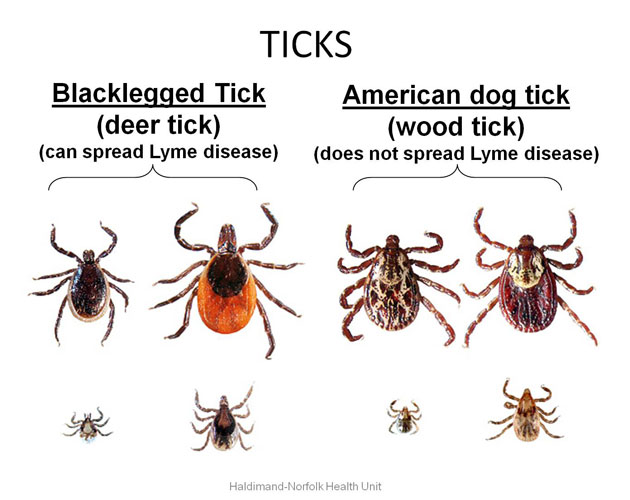- Home
- Health Topics
- Diseases
- Lyme Disease
Lyme Disease

What is Lyme disease?
Lyme disease is a bacterial infection transmitted to humans by a bite from an infected blacklegged tick (Ixodes scapularis), commonly referred to as deer ticks.
What does the tick look like?
The blacklegged tick is very small and in the larval stage is about the size of a period on this page. The adult tick is orange-brown in color.
Where are the ticks found?
Established colonies of blacklegged ticks have been found in Long Point Provincial Park as well as Rondeau Provincial Park and Point Pelee National Park. More recently, smaller numbers of colonies have been identified in the Turkey Point area. Tick habitat includes wooded areas, marshlands, and tall grassy areas. Individual ticks have been found at other sites throughout the province, but investigation to date has not shown any other established colonies. It appears that birds may pick up the ticks during their south-to-north migration and carry individual ticks to other areas. Ticks that are known to be associated with lyme disease are more widespread in Atlantic seaboard states of the U.S.A. and upper north central states as well as northwestern California.
How do humans get Lyme disease?
The ticks are active in warm weather, usually from May to October, but can be active during warm periods in March, April and later in the fall. The ticks prefer wooded areas, marshlands and tall grasslands. In the wild, the ticks can be found on birds, mice, raccoons, deer, etc. Domestic animals such as dogs, cats, horses and cows can also carry the tick if they’ve been in tick-infested areas.
A tick bite does not mean that lyme disease will follow. Not all blacklegged ticks carry lyme disease. According to the C.D.C. (Centres for Disease Control) transmission of infection is unlikely to occur before 36 hours of tick attachment. Prompt removal of the tick will lessen any chance of disease transmission.
How to prevent Lyme disease
- Don’t walk barelegged in tall grass, wooded areas or marshlands.
- Wear long sleeves, slacks and fully-closed boots or shoes when walking in grassy or wooded areas.
- Tuck pant legs into socks.
- Wear light-coloured clothing to make the ticks easier to find.
- Insect repellents containing DEET (N,N-diethyl-meta-toluamide) are useful and can be sprayed onto clothing, especially pants and socks. Please read the label when using any repellents, in particular when using them on young children. For safety tips on using DEET personal insect repellents visit the following website: www.hc-sc.gc.ca and search “insect repellents.”
Conduct a “tick check” on yourself, your family and your pets after exposure to tick habitat.
How to remove ticks
- Never use a match, heat, chemicals, alcohol, ointments, petroleum or squeezing to remove a tick. This may cause the tick to regurgitate or burst and expel fluid into you, increasing the risk of transmitting the disease.
- Remove attached ticks with tweezers (needle-nosed tweezers are the best).
- Grasp the tick as close to the skin as possible and gently pull it straight out.
- Do not twist or jerk the tick out. This may cause its mouth parts to break off and remain in the skin.
- Wash hands and apply antiseptic to the bite area.
- Record the date and place where tick was picked up and the location of the bite on the body.
Online tick identification
eTick is a free electronic tick identification service available online or by downloading the mobile eTick app. Send in a photo of your tick and it will be identified within 48 hours. They will contact you with the results and provide the necessary public health information. View all the ticks eTick has identified on their public tick map.
Symptoms of lyme disease
The first symptom in 80% of cases is a circular red skin rash around the bite area within three to 30 days after the bite. The rash may get larger to form a red ring with a clear center. This “bull’s-eye” rash can be as large as a “loonie” or a dinner plate. Other early symptoms may include flu-like symptoms with fatigue, fever, headache, stiff neck, muscle aches, and joint pain.
If not treated, the symptoms may disappear and more serious problems with the nervous system, heart and arthritis may occur weeks or months after the bite. In some cases, the bite may cause no reaction.
Diagnosis and treatment
If you have been bitten by a blacklegged tick or develop symptoms or suspect lyme disease, see your doctor immediately. Lyme disease is a potentially crippling condition, but it is usually treated successfully with antibiotics if detected early. The longer it goes undetected the more difficult it is to treat and may develop into a serious chronic condition.
For more information on Lyme disease or to report a blacklegged tick call the Lyme disease information line at 519-900-9600.
Rocky Mountain Spotted Fever
Rocky Mountain Spotted Fever (RMSF) is a serious disease caused by the bite of an infected tick. RMSF has been detected in pets who have recently visited Long Point. Without early treatment, RMSF can be life threatening in both humans and animals. Make sure to avoid tick infested areas and check yourself and your pets thoroughly after spending time outdoors.
Learn more in our Rocky Mountain Spotted Fever Fact Sheet.
